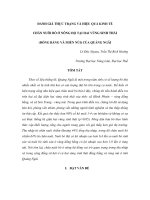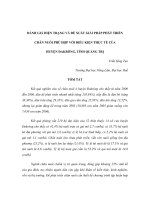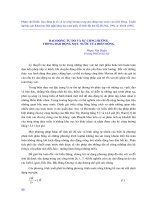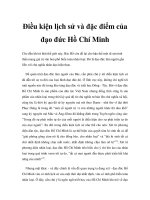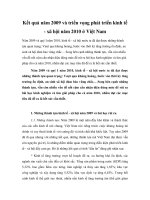Báo cáo nghiên cứu khoa học: "CHÍNH SÁCH TIỀN TỆ VÀ KHÔNG HOÀN CHỈNH thị trường tín dụng" pptx
Bạn đang xem bản rút gọn của tài liệu. Xem và tải ngay bản đầy đủ của tài liệu tại đây (315.27 KB, 8 trang )
TẠP CHÍ PHÁT TRIỂN KH&CN, TẬP 10, SỐ 08 - 2007
Trang 77
MONETARY POLICY AND CREDIT MARKET IMPERFECTION
Luong Tuan Anh
Princeton University, USA
ABSTRACT: Credit market imperfection prevents the economy from attaining its full
potential. This paper examines the change in monetary policy in presence of this imperfection.
Using the Corsetti-Pesenti model, this study shows that when credit market is not needed or
perfect, monetary policy should respond fully to productivity shock. However, when credit
market is in need but imperfect, the extent to which monetary policy responds to productivity
shock should depend on the degree of credit market imperfection. The less perfect the credit
market, the less the response.This study also shows that credit market imperfection might not
be sustainable, which calls for government interventions.
Keywords: Monetary Policy, Credit market Imperfection, Productivity shock.
1. INTRODUCTION
Credit market imperfection has been an issue in almost every country. It might arise from
asymmetric information: banks perceive incorrectly the risk exposure of firms, hence can not
fully provide credit to them. The severeness might however vary across countries. Its damages
are various: preventing human capital investment (Lambertini 2001; Tesfatsion and Orazem
1997; Shea 1997), increasing inequality through distribution effect (Reto and Oechslin 2003;
Iradian 2005), leading to high unemployment (Acemoglu 2000; Wasmer and Weil 2000) or
preventing firms from switching to more productive and capital-intensive technology (Horii,
Ohdoi and Yanamoto 2005).
Surprisingly, the literature of credit market imperfection does not examine quantitatively
the effect of this imperfection on the number of firms in the economy. Asymmetric
information might lead to quantitative constraint in credit market (Stiglitz and Weiss 1981;
Jaffe and Russel 1976). This credit constraint will reduce the number of firms, therefore
affects output. Our paper aims to close this gap via the price of asset. It extends the Corsetti
and Pesenti (2005) framework. In particular, there will be a representative consumer, a
continuum of firms, a bank and a policy maker. The firms will need to acquire one unit of land
(assets) as fixed investment before being able to produce. This requirement implies that these
firms will need to borrow from the bank. It is showed that when credit market is not needed
(i.e. no loan request) or when it is perfect (i.e. loan requests are satisfied entirely) monetary
policy should respond fully to productivity growth. However, when credit market is needed
but imperfect monetary policy responds to this growth only to the extent of this imperfection.
It is also showed that this imperfection is unsustainable, leaving the need for government
interventions to fix it.
The rest of the paper as follows. The second section will present the model, how the
representative consumer, the bank and the firms react to productivity shocks. It then shows us
how the government should intervene, and examines whether the imperfection needs to be
fixed. The last section concludes.
2.THE MODEL
In our model, land appears as assets. At the first place (period 0), each consumer
possesses one unit of land. He (she) can use his land by 2 ways: either to hold it which brings
Science & Technology Development, Vol 10, No.08 - 2007
Trang 78
him some utility (for instance, think about land providing him shelters or playing grounds), or
sell to the firms. Land is assumed to be divisible, so a portion of it can be sold. There is a
continuum of firms, normalized by 1. The competition is imperfect. Each firm provides one
variety a la Dixit-Stiglitz. Each firm needs to buy one unit of land as a fixed cost. As opposed
to hiring labor, the firms need to borrow from the bank to buy this unit of land (i.e. each firm,
in order to produce, buys one of land at the beginning of the period, hires some labor, produces
and then pays the wage bill at the end of the period). Although loans yield the same interest as
bonds, it is assumed that they are not substitutes: the firms can only borrow from the bank, not
from the consumer.
The credit imperfection arises from information asymmetry. The bank perceives
imperfectly the risk of the firms that need credit. This is usually the case in developing
countries, where the financial market is not well developed, where banks don’t have enough
information to evaluate the projects presented by the firms. As a consequence, some firms
(perceived as low risk) can get the loans they need, while others (perceived as high risk ones)
can not.
In our set up, the monetary stance (the government’s control) will be the consumption
expenditure. Money has two components: the monetary stance and the credit granted to the
firms. The former does not pay any interest while the latter does. The policy maker can only
control the first component, but not the second due to credit market imperfection.
3. THE CONSUMER
Because of the frictions created in our set up (fixed cost, credit imperfection) the number
of firms that produce will not be always be one. We call that
t
N ( 01
t
N
≤
≤ ). The problem of
choosing the optimal basket of goods is then:
1
1
1
{()}
0
max ( )
t
t
N
t
Cj
Cjdj
θ
θ
θ
−
−
⎛⎞
⎜⎟
⎜⎟
⎝⎠
∫
subject to the spending constraint:
0
() ()
t
N
tt
p
jC jdj E=
∫
where
E is the spending on consumption goods.
Solving this problem gives us the following solution:
()
()
t
tt
t
pj
Cj C
P
θ
−
⎛⎞
=
⎜⎟
⎝⎠
(1)
where
1
1
1
0
1
()
t
N
tt
t
CCjdj
N
θ
θ
θ
−
−
⎛⎞
=
⎜⎟
⎜⎟
⎝⎠
∫
the consumption index (2)
and
1
1
1
0
1
()
t
N
tt
t
P
pjdj
N
θ
θ
−
−
⎛⎞
=
⎜⎟
⎜⎟
⎝⎠
∫
the price index. (3)
TẠP CHÍ PHÁT TRIỂN KH&CN, TẬP 10, SỐ 08 - 2007
Trang 79
We will see that in equilibrium all firms behave the same way (i.e. setting the same price
and producing the same level of output). In this case the consumption expenditure is
0
() ()
t
N
tt ttt
EpjCjdjNPC==
∫
The utility of a representative consumer is assumed to have the following
form:
(,,)ln
ttt t t t
uC l x C hl x
χ
=−+
where
t
l
is his labor and
t
x
is the fraction he decides to
keep. The budget constraint is:
111
(1 ) (1 ) (1 )
tt t t t t t t tt t t t t
NPC B x Q i B l xQ N
ω
−−−
++− =+ + +− +Π
(4)
The spending for consumption
tt t
NPC and bonds
t
B
plus the price
1
(1 )
tt
x
Q
−
− to buy
back the fraction of land he sold a period earlier must be equal to the interest on bonds
11
(1 )
tt
iB
−−
+
, the labor income
tt
l
ω
, the land income
(1 )
tt
x
Q
−
and the profit of the firms
redistributed to the representative agent
tt
N
Π
. To make the problem symmetric, the firms will
sell the unit of land they acquired a period earlier to the consumers after their project finish at
the end of the current period. This won’t make the problem less general as all transactions are
done at the market price, yet we don’t need to keep track on the land holding of the
representative consumer as he always has one unit of land at the beginning of each period.
The representative consumer has to maximize his expected utility
{,,}
max ( , , )
ii iit
it
tiii
Clx
it
EuClx
β
∞
=
∞
−
=
∑
subject to the budget constraint (4)
The first-order conditions are given by:
1
ttt
t
NP
C
λ
=
(5)
tt
h
λ
ω
= (6)
11tt tt t
QEQ
χ
λβλ
+
+
=−
(7)
(
)
11
1
tttt
iE
λ
βλ
+
+
=+ (8)
With
t
λ
the Lagrangian multiplier. The condition (8) assures that the representative
consumer will be indifferent about selling or holding bonds.
4. THE BANK
Economic growth (due to a positive productivity shock) will require money expansion.
This will drive up the price of land, and put pressure on the credit market. The bank however
has a limited ability to provide credits to the firms. The bank will only grant the loan needed
t
Q to
t
N firms. The budget constraint of the bank is therefore:
111111
(1 ) (1 )
tt t t tt tt tt
BiNQ iBNQ
μ
μ
−−−−−−
−+++ =+ +
(9)
Science & Technology Development, Vol 10, No.08 - 2007
Trang 80
Where
t
μ
is the monetary stance. As this is controlled by the policy maker, and the credit
needed
tt
NQ derived from the next section, all the bank does is to buy (or sell) bonds
t
B
to
(or from) consumers to balance (9). Since consumers are indifferent about holding or selling
bonds, this is always feasible.
5. THE FIRM
The production function is assumed to have the form
ttt
YAL
=
where
t
A
is the
productivity and
t
L is labor. Credit market imperfection implies that some firms can not get
the loan they need. The bigger the loan, the less chance they get the loan. To formalize this, we
assume that the probability of getting an amount
γ
of loan is given by:
1
()
(1)
k
f
k
γ
γ
=
−
for
γ
>1 and 1<k<2 (10)
Consider a firm j at time t-1. Assuming nominal rigidities, price at time t is set at time t-1.
Given the demand
()
()
t
tt
t
pj
Cj C
P
θ
−
⎛⎞
=
⎜⎟
⎝⎠
derived in the consumer section, firm j maximizes
its profit:
()
11,
()
()
max ( )
t
t
ttt t t t
pj
t
pj
Eq pj MC C
P
θ
−
−−
⎛⎞
−
⎜⎟
⎝⎠
where
1,tt
q
−
is the stochastic discount factor and
t
M
C
is the marginal cost.
The first-order condition is given:
()
11, 11,
() ()
1
()
ttt
ttt t ttt t
ttt
pj MC pj
Eq C Eq C
PpjP
θθ
θθ
−−
−− −−
⎛⎞ ⎛⎞
−=
⎜⎟ ⎜⎟
⎝⎠ ⎝⎠
(11)
Rearrange terms and note that in equilibrium
()
tt
pj P
=
we get the price level:
1
1
()
1
1
t
t
t
t
t
t
M
C
E
N
pj
E
N
θ
θ
−
−
=
−
(12)
The expected profit for firm j will be:
()
1
,1 1 ,1 1 1 1
1
()
()
t
ttt t ttt t t t
t
pj
Eq Eq p j MC C
P
θ
−
+
++ + + + +
+
⎛⎞
Π= −
⎜⎟
⎝⎠
=
1
11
1
1
tt t t
t
tt
NPC MC
E
PN
β
θ
+
++
−
=
1
1
tt
t
E
N
β
μ
θ
+
(
tttt
NPC
μ
=
and from (12)) (13)
TẠP CHÍ PHÁT TRIỂN KH&CN, TẬP 10, SỐ 08 - 2007
Trang 81
From (5), (7) and (8) we get
1
tt
Q
χ
μ
β
=
−
(14)
We see that a loose monetary policy will drive up land price. The cash flow of the firm j is
the following: at the beginning of each period, it gets the credit from the bank to buy the
required unit of land, then it hires labor, produces and gets profit
t
Π
. At the end of that period
(or equivalently at the beginning of the next period), it has to pay back the loan to the bank but
it sells the land it acquired to the consumer. The no-arbitrage condition provides:
(
)
,1 1
(1 )
tttt ttt
Eq i Q Q
++
Π= + − (15)
or
,1 1tttttt
QEqQ
+
+
=Π + (16)
Combine (13), (14) and (16) provides the expected number of firms:
1
1
t
t
E
N
χ
θ
+
=
(17)
We also have:
Pr( )
tt
NQ
γ
=>
=
1
(1)
t
k
Q
d
k
γ
γ
∞
−
∫
=
1
1
k
t
Q
−
(18)
From (14) we have:
()
1
11
1
k
t
kk
t
N
β
χμ
−
−
−
−
=
(19)
The number of firms decreases with the monetary stance. Bordo and Jeanne (2002) get the
same result: an expanding monetary policy will decrease the real value of the firms’ collateral,
therefore prevents them from borrowing.
Formula (19) holds when
t
Q is bigger than 1, which is true if
β
is close to 1 and
t
μ
not
too small. The amount of credit granted is:
()
2
222
1
1
k
tt
kkk
tt
NQ
Q
β
χμ
−
−
−−
−
== (20)
We see that credit increases at a quicker speed than monetary stance if k<1, at a slower
rate than monetary stance if 1<k<2 and even decreases if k>2. Therefore it’s reasonable to
assume that 1<k<2, when credit increases slower than monetary stance. To close the model,
we need to derive the demand for labor and consumption:
Science & Technology Development, Vol 10, No.08 - 2007
Trang 82
1
1
1
1
k
tt t t t
t
k
t
tt
t
t
NC E
l
h
AA
E
A
μμ
θ
μ
θ
−
−
−
−
==
(21)
(
)
1
1
k
tt
t
k
t
tt
t
t
C
PN h
E
A
θχ
μμ
μ
−
−
==
(22)
6. THE POLICY MAKER
The policy maker is assumed to concern only about output (GDP). His objective is then:
{}
max ln
sst
st
tts
st
EEC
μ
β
∞
=
∞
−
=
∑
Use the formula
((( ))
'( ( ( )) '( )
df E g X
f
EgX g X
dX
= we have the first-order conditions:
1
1
k
t
t
k
t
t
t
t
k
A
k
E
A
μ
μ
μ
−
−
= or
1
kk
tt
t
tt
E
A
A
μ
μ
−
= (23)
The optimal monetary policy is then
1
1
k
ttt
A
μα
−
=
: monetary policy responds to the
productivity shock
t
A
to the extent of the credit market imperfection k (remember that k=1
means the market is perfect). The constant
1t
α
−
is chosen as a nominal anchor. For instance, if
π
is the desired inflation rate, i.e.
1
1
t
t
P
P
π
−
=
+ then
1
1
(1 )
t
t
απ
−
−
=+ .
7. IS CREDIT MARKET IMPERFECTION SUSTAINABLE?
If the country accepts an inflation rate different from 0, the coefficient
α
will rise
exponentially, and so does
t
μ
. If the credit market is not too imperfect (k is close to 1) the
number of firms will drop at a lower rate (see 19). To see it clearer, we can compute the time it
takes before the economy collapses (assume that it occurs when the number of firms that can
not get credit is 30%). If each period is 1 year, we have the following table:
π
=2%
π
=5%
π
=10%
k=1.05 360 years 146 years 75 years
k=1.1 180 years 73 years 37 years
k=1.5 36 years 15 years 7 years
We can see from the table that if the market is not imperfect (k=1.05) and the government
can control the inflation rate at 2%, it will take 360 years before the economy collapses.
TẠP CHÍ PHÁT TRIỂN KH&CN, TẬP 10, SỐ 08 - 2007
Trang 83
However, if the market is less perfect (k=1.5) and the inflation is quite high at 10%, it only
takes 7 years before the economy collapses.
8. CONCLUSION
This paper has shown that monetary policy should respond to the productivity shock to the
extent of market imperfection. The imperfection needs to be fixed sooner or later depending on
its severeness. Building a structural form of credit market imperfection (as in Gil 2003) will
help derive the degree of credit market imperfection. This can be done in future research.
CHÍNH SÁCH TIỀN TỆ VÀ THỊ TRƯỜNG TÍN DỤNG KHÔNG HOÀN HẢO
Lương Tuấn Anh
Trường Đại học Princeton, Hoa Kỳ
TÓM TẮT: Sự không hoàn hảo của thị trường tiền tệ có thể ngăn cản nền kinh tế phát
triển. Để nghiên cứu về vấn đề này, chúng ta có thể sử dụng mô hình của Corsetti và Pesenti,
qua đó có thể thấy rằng nếu thị trường là hoàn hảo thì chính sách tiền tệ sẽ phải đáp ứng đầy
đủ nhu cầu tiền tệ
cho nền kinh tế. Tuy nhiên khi các ngân hàng không thể đánh giá đúng mức
độ rủi ro của các dự án cho vay, một chính sách siết chặt tiền tệ sẽ là tối ưu hơn. Mức độ siết
chặt phụ thuộc hoàn toàn vào sự phát triển của thị trường. Hơn nữa chúng ta cũng sẽ thấy tùy
vào mức độ hoàn hảo của thị trường mà sự điều chỉnh của Nhà nước là cấp thiết hay không.
REFERENCES
[1]. Acemoglu, Daron, Credit market imperfections and persistent unemployment, NBER
Working Papers, (2000).
[2]. Bordo, Michael and Jeanne, Olivier, Boom-bursts in asset prices, economic
instability and monetary policy, Centre for Economic Policy Research, (2002).
[3]. Corsetti, Giancarlo and Pesenti, Paolo, The simple geometry of transmission and
stabilization in closed and open economies, Federal Reserve Bank of New York Staff
Report, No.209.(2005).
[4]. Dixit, Avinash and Stiglitz, Joseph E., Monopolistic Competition and Optimum
Product Diversity, American Economic Review, (1977).
[5]. Foellmi, Reto and Oechslin, Manuel, Who gains from non-collusive Corruption,
Institute for Empirical Research in Economics, (2003).
[6]. Gil, Pedro Mazeda, A Model of Firm Behaviour with Equity Constraints and
Bankruptcy Costs, Working paper, (2003).
[7]. Horii, Ryo and Ohdoi, Ryoji and Yamamoto, Kazuhiro, Finance, Technology and
Inequality in Economics Development, Economics Working Paper Archive WPA,
(2005).
[8]. Iradian, Garbis, Inequality, Poverty and Growth: Cross-country Evidence, IMF
working papers, (2005).
Science & Technology Development, Vol 10, No.08 - 2007
Trang 84
[9]. Jaffee, Dwight M. and Russell, Thomas, Imperfect information, uncertainty and
credit rationing, Quarterly Journal of Economics, 90, 651-666, (1976).
[10]. Lambertini, Luisa, Technological change and Public Financing of Education, Boston
College Working Papers in Economics, (2001).
[11]. Shea, John, Does Parents' money matter?,NBER Working Papers 6026, (1997).
[12]. Stiglitz, Joseph E. and Weiss A, Credit rationing in markets with imperfect
information, American Economic Review, 71(3), 393-410, (1981).
[13]. Tesfatsion, Leigh and Orazem, Peter, Macrodynamic implications of Income transfer
Policies for Human Capital Investment and School Effort, Journal of Economic
Growth, (1997).
[14]. Wasmer, Etienne and Weil Philippe, The macroeconomic of Labor and Credit market
imperfections, CEPR Discussion Papers 3334, (2000).

